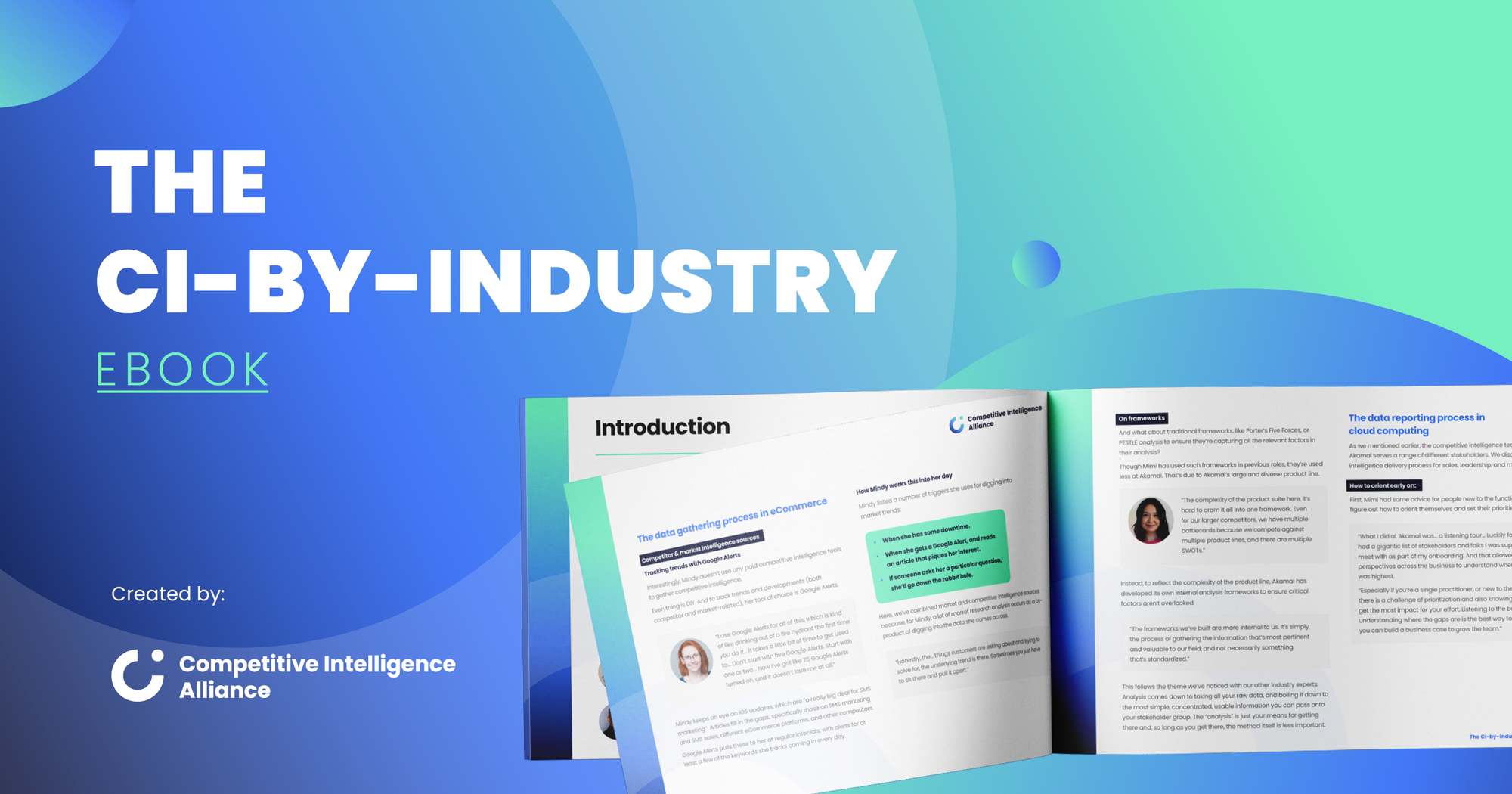We get it. Much of the time, you’ll want to get your competitive intel straight from the horse’s mouth. 🐴
But confining yourself to working only with external sources of competitive intelligence paints you into a corner. Fast.
We all know competitive intelligence teams are small, and budgets are limited. If you want to be effective, you must work efficiently.
Thankfully, you’ve got dozens of reps dotted around the business, beavering away doing competitive intelligence work without even knowing it.

Leverage this existing, willing workforce, and you’ll kickstart the success of your competitive program faster than you could believe.
Here’s our guide on how to gather competitive intelligence from internal teams and stakeholders. 👇
Orient with the company’s goals and objectives first
Making sure you’re on board with your company’s goals and objectives is always your starting point. Already know your business’ objectives? Great, you can move on. But if you can’t articulate those goals right now, you’ll need to seek them out and make sure you’re crystal clear on what they are.
Why is this important? Your company goals will serve as your frame of reference when collecting intel from your internal teams, and will help you to ask the right questions, and to pick out the important stuff.
Internal sources of competitive intelligence
We’ll walk you through collecting competitive intel from internal teams and stakeholder groups in terms of the actions themselves, rather than listing through ways to extract information from each team one-by-one.
Not only can you use some of the following methods to gather data from more than one team, but you can just look down the list of actions, check off those you’re already doing, and pick up those you’re not.
Be sure you’re collecting data from these teams
First, here’s a quick list of the teams you’ll want to make sure you’re collecting from:
- Sales teams.
- Product teams.
- Leadership.
- Customer success teams.
- Marketing teams.
Why these teams?

For the 2023 Competitive Intelligence Trends Report, we asked respondents which teams provide them with competitive intel most regularly.
Sales came in top, supplying 83.33% of respondents with intel. Product and leadership came in second and third, providing 48.48% and 43.94% of our survey takers with intel and information.
Depending on the goals and objectives of your business (we told you they were important!) there might be others, too, but these teams make up the core most will want to prioritize.

Most popular internal gathering methods
The best competitive intelligence pros are proactive. They don’t wait for other teams to give them intel, they provide those teams with processes and places to log and share that intel when they come across it.
For the CI Trends report, we also asked survey takers how they collect competitive intelligence from other departments.

Email correspondence leads the way, with 60.61% of respondents using this method. 59.10% of our survey takers reported using a dedicated Slack channel, or similar solution.
Let’s examine some of your options in detail:
- Competitive Slack channel.
- Sync meetings.
- Rep interviews.
- Competitive workshops.
- Internal software and tools.
1) Competitive Slack channel
First up is the competitive Slack channel. (Or Microsoft Teams, or any similar software solution.)
Basically, wherever you do your messaging, make sure there’s a dedicated spot for folks to throw their ad hoc competitive findings.
A dedicated competitive feedback channel allows people to deposit those “through the grapevine” discoveries, no matter which team they’re in. If one of the development team picks up the phone on a busy day and hears something they want to feed back, for example, they can do so.
One of the key benefits of a dedicated channel is it encourages the coveted “culture of compete,” where everyone in the business considers themselves, in-part, responsible for competitive success. This is essential if your small CI functions is to thrive.
The findings you get won’t be well organized, but you can use your software’s search function to filter on:
- Particular keywords,
- The person who posted the message,
- A particular date range.
Smart use of these search filters will help you locate key information after the fact, and organize related findings for subsequent write-ups.
2) Sync meetings
Sync meetings are meetings you’ll own and hold with some frequency.
Just how frequently is up to you, but you should check in with all your stakeholder groups from time-to-time. Remember, that includes your:
- Product,
- Sales,
- Customer success,
- And leadership teams.
You might need to hold sync meetings with some groups, like leadership, less often out of necessity. Leaders are busy, after all.
The purpose of the sync meeting? To sit down with a number of representatives from each stakeholder group at once, and to get a high-level overview of what they’ve been seeing.

These meetings are most useful if reps spend some time beforehand thinking through what they’ve heard, and what they’ve found, over the last month, or the last quarter. So send out some pre-reading material, or some questions for reps to consider, before the meeting to ensure everyone comes prepared.
Again, sync meetings are most useful when you’re looking to get a sense of shared perspective from an entire stakeholder group. This should help inform you of mid- to long-term industry trends that are developing right now.
When you want to drill down deeper, you should hold rep interviews instead.
3) Rep interviews
Rep interviews are (most often) one-on-one meetings. These allow you to get more granular, and to:
- Question individual reps about things you’ve heard from them.
- Corroborate things you’ve heard from others in the business.
- Develop a deeper understanding of an emerging competitive development.
Here, too, you’ll find it useful to conduct rep interviews with individuals from all your usual stakeholder groups. But you don’t have to.
It’d be impractical to interview every rep from every team, so you naturally have to be more selective about whom you speak to. That’s why it pays to have these one-on-one catch-ups with reps reactively. This in contrast to sync meetings, which it’s best you proactively book into your calendar, and hold at regular intervals.
Here are some things that might trigger a rep interview:
- Seeing something interesting in someone’s sales notes, or noted down in the CRM.
- Seeing something reported in the competitive Slack channel.
- Hearing something over call recording, or reported via conversation intelligence software.
- Overhearing something in the office.
You shouldn’t really need to think about this.
Something caught your eye? Something pricked your ears up? Go check it out. That’s the guiding principle of the rep interview as a source of internal competitive intelligence.

CI-by-Industry eBook
Download your copy to learn...
- 😰 Why field intelligence can be dangerous, and how to use it the right way. (Page 24)
- 🙅♂️ Why you should think twice before having reps from this team on a win/loss call. (Page 24)
- 🤖 The truth about automation, and how much time tools can really save you. (Page 22)
- 🤯 The surprising key skill every one of our industry experts said was crucial for CI success. (Page 66)
4) Competitive workshops
Most often, a competitive workshop is a time for you to share your findings with others.
However, like all good means of communication, a competitive workshop will spur a dialogue between you and its participants.
This can be especially useful for uncovering information reps consider common knowledge, or underestimate the importance of. Role playing a competitive scenario with your sales reps is the perfect way to shine a light on this kind of information. Chances are, at least once per workshop, you’ll hear something that blows your mind.
5) Internal software and tools
Your internal software and tools should collect competitive information as a matter of course. Either by virtue of a process, like sales reps noting down findings in the CRM, or automatically, like conversational intelligence software automatically recording calls and pulling out findings for you.
Make a habit of periodically checking your internal software and tools for new competitive intelligence.
Challenges when gathering CI from internal teams
Some sales reps, and perhaps even some customer success reps, will go rogue.
This might sound strange, but think about their incentives, and you’ll understand why.
The problem 😡
Your sales reps are benchmarked against their peers. As a result, they want to outperform the people sitting next to them. This means they’re all seeking their own competitive edge over one another.
Seeking out new competitive intelligence, and developing bespoke enablement materials for themselves, is a core part of this. This information, and the way it’s delivered, can be invaluable for you and the rest of the business if you can uncover it.
But uncovering it isn’t always easy.
Think about this from the rep’s perspective. If Jack from sales stays late three nights a week, poring over notes from calls, and collating all the information that might improve his performance, why should anyone else benefit from his hard work? That’s his performance bonus on the line.
So what do you do about this?
The solution 😇
Pull Jack aside and explain it to him like this:
You’ll make sure he gets all the credit. He did the work, and he developed this material, so that’s only fair.
You’ll take personal responsibility for rolling out Jack’s findings and assets to the rest of the team, so there won’t be any additional work for him.
At the same time, you’ll make sure Jack is the face of this roll out, and you’ll track adoption of his content. This way, you’ll be able to tie increases in revenue back to his hard work.
Jack should now get more recognition and reward for having impacted company revenue on a scale far greater than he’d have been able to do alone.
This should be persuasive enough to open up even the cagiest and most competitive of reps, no matter who they are, or what team they work in.

External sources of competitive intelligence
Of course, internal sources of competitive intelligence aren’t your only option.
You can, and should, work hard to uncover information directly from the source yourself.
However, successfully establishing a culture of compete lets you cast a much wider net for intel than you’d ever be able to do alone. You essentially crowdsource the efforts of others, and leverage the work many are already doing, to massively boost the effectiveness of your competitive program.
Some external sources of competitive intelligence you should consider include:
- Social media mentions.
- Customer feedback.
- Win/loss interviews.
- Competitor websites.
- Press releases.
- Public newsletters and news articles (industry-wide or competitor generated).
- Competitor help and support documentation.
- Broader market intelligence.
For more information on gathering competitive intelligence, check out our practitioner’s complete guide to competitive intelligence.
How to use the intelligence you’ve gathered
Once you’ve gathered all that information, what do you do with it? 🤔
The first thing to do is to consolidate all the information. You’ll want to tie-in all the findings you’ve gathered via external sources of competitive intelligence, too.
Second, you’ll want to analyze this information. How you do this is up to you. You can apply formal analysis frameworks, like SWOT analysis and PESTLE analysis. If you prefer, you can ponder your way through it, and use your experience and expert intuition to guide you in tying threads together between various pieces of intel.
The purpose at this stage is to come to conclusions about how what you’ve learned should inform your business’ strategy, along with any other deliverables you’re responsible for.
If you’re responsible for enabling your sales team, for example, then you should be looking to pick out findings that could help your sales reps to win more deals. You might learn something that impacts how you feel reps should position your product against a particular competitor.
If you’re responsible for improving product messaging, you’ll want to sift through customer feedback for telltale signs of (perceived) unmet needs your product or service can already fill.
Here’s a list of ways in which your competitive intelligence research can benefit your business:
- Informs the business’ decision-making processes.
- Offers deeper understanding of the competitive landscape, and your place within it.
- Helps you understand, and be able to handle, the threats and opportunities presented by the state of your competitors’ products and services.
- Helps you establish a sustained competitive advantage.
- Informs your marketing strategies.
- Creates better understanding of customer pain points.
Learn how the pros do it
Looking for more guidance on how to run a successful, impactful competitive intelligence program?
We spoke to veterans from five different industries.
No matter how unique the challenges you're facing are, you're bound to find applicable wisdom in the CI-by-Industry eBook.
Learn more below, then grab your complementary copy. 👇

CI-by-Industry eBook
Download your copy to learn...
- 😰 Why field intelligence can be dangerous, and how to use it the right way. (Page 24)
- 🙅♂️ Why you should think twice before having reps from this team on a win/loss call. (Page 24)
- 🤖 The truth about automation, and how much time tools can really save you. (Page 22)
- 🤯 The surprising key skill every one of our industry experts said was crucial for CI success. (Page 66)





.png?v=b84d65a2be)